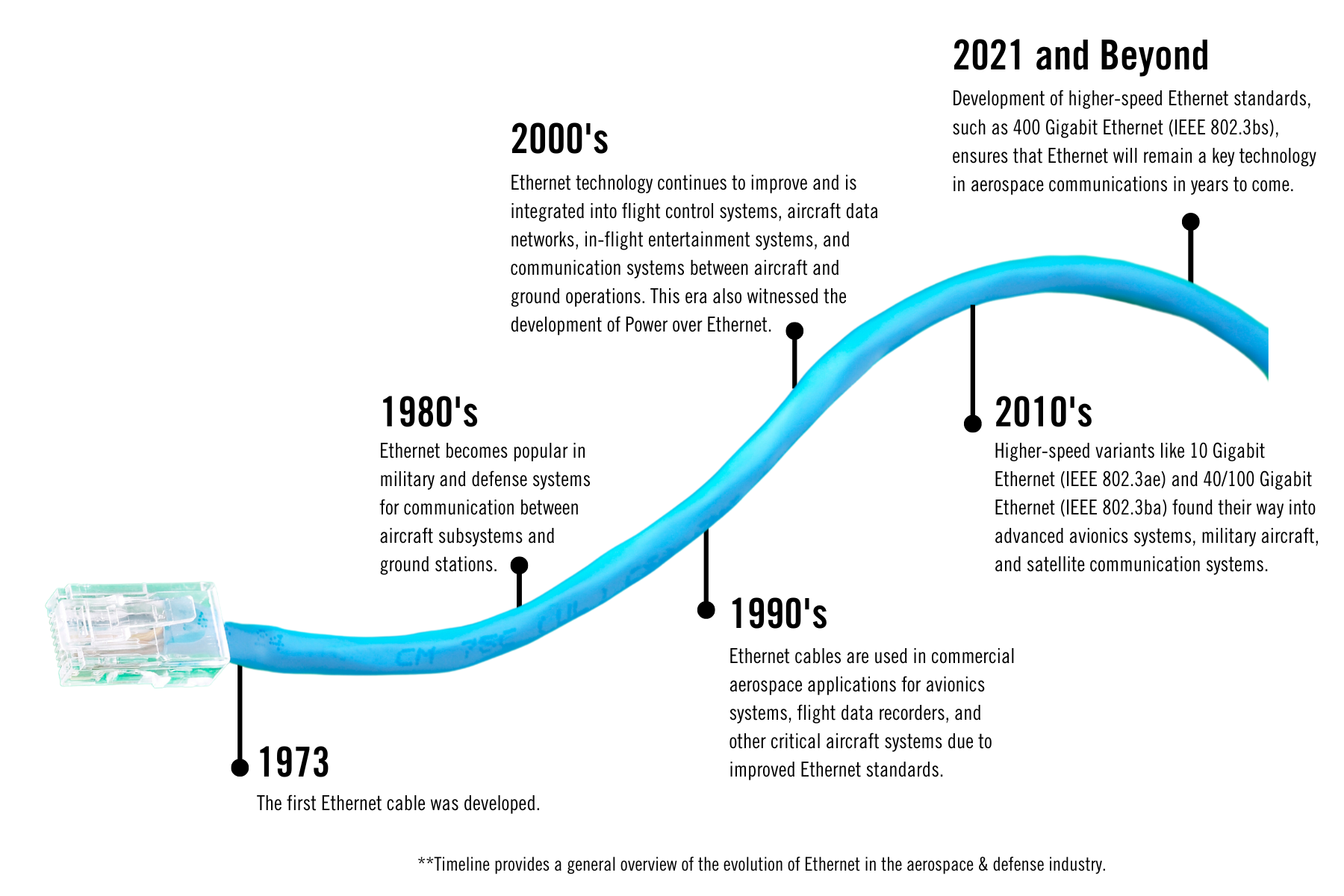System Integration Obstacles: Outdated Coaxial Cable Options
For half a century, Ethernet cables have served as the fundamental support for countless interconnect applications, revolutionizing our data-sharing and communication methods. Ethernet cables have come a long way since their inception, evolving alongside technological advancements to meet the growing demand for faster and more reliable data transmission. Nowhere is this evolution more evident than in the aerospace and defense industries.
THE EARLY DAYS
The first Ethernet cable was developed in 1973 at the Xerox Palo Alto Research Center by Robert Metcalf and David Boggs. This initial design consisted of a thin coaxial cable that was able to meet the 10BASE2 requirements.
MIL-STD-1553 was introduced in the late 1970s and early 1980s and served as a precursor to Ethernet in the aerospace and defense market. It laid the foundation for the utilization of similar cable technologies by utilizing a dual-redundant twisted-pair cable for data communication between avionics systems. This system provided basic networking capabilities. As aerospace and defense technologies advanced, the need for higher bandwidth speeds became increasingly crucial.
GROWING DEMANDS FOR BANDWIDTH
With the ever-growing demand for higher bandwidth speeds in aerospace and defense applications, advancements in Ethernet cables were imperative. As a result, Cat5e (Category 5e) and Cat6 (Category 6) cables were introduced, providing enhanced data transmission rates, reduced crosstalk, and improved noise resistance. These upgrades facilitated the transition from traditional coaxial cables to Ethernet-based networks, offering increased reliability and faster communication within aircraft, satellites, unmanned systems, and ground stations.
ETHERNET CABLE UPGRADES FOR HIGHER BANDWIDTHS
As aerospace and defense systems continued to evolve, newer applications, such as real-time data streaming, advanced surveillance, high-resolution imagery, and autonomous systems, demanded even higher bandwidth speeds. Traditional Ethernet cables were unable to meet these escalating requirements, prompting the development of CAT8 cables.
PIC Wire & Cable® is excited to introduce the latest addition to the PICMates® Ethernet cable family portfolio – CAT8. Our CAT8 (Category 8) cable is specifically designed to cater to the demanding bandwidth needs of aerospace and defense applications. This Cat8 cable is built for data transmission up to 40 Gb/s at lengths up to 90 ft. It exceeds MIL-DTL-83526 and can operate at frequencies up to 2 GHz. With improved shielding and reduced crosstalk, the E84824 CAT8 cable ensures reliable and high-speed communication in environments prone to interference.
“We are proud to introduce our latest CAT8 cable, which represents a significant advancement in high-speed data transfer,” said Bryan Loeb, Product Manager at PIC Wire & Cable. “With its unmatched performance, exceptional reliability, and advanced features, this cable empowers aerospace and defense professionals to achieve seamless data transfer and maintain the highest level of operational efficiency and security.”
PICMates CAT8-E84824 cable construction is shown below:

INTRODUCTION OF CAT8 CABLES
We have conducted extensive testing with the Electrical Wiring Interconnect System (EWIS) to ensure system and environmental performance for jacket abrasion, thermal shock, fluid immersion, smoke density, toxicity, shrinkage and several other environmental factors that can impact its performance in harsh environments. PICMates are backed by our rigorous testing and commitment to deliver the highest quality products to meet your interconnect requirements.
E84824’s cable construction features superior shielding technology, including individually shielded pairs with an overall braid shield. This advanced shielding minimizes electromagnetic interference (EMI) and crosstalk, ensuring uncompromised signal integrity. This cable safeguards data accuracy and reliability, making it suitable for complex aerospace and defense systems.
Cat8 is backward compatible to ensure seamless integration into existing infrastructure; reducing the number of cables needed while maintaining high-speed connectivity. This space-saving solution helps preserve weight in critical aerospace applications.
CAT8 cable provides a secure and future-ready solution for aerospace and defense networks, supporting the integration of emerging technologies such as IoT, artificial intelligence, and edge computing. With its exceptional performance, CAT8 ensures seamless connectivity and adaptability to the evolving requirements in aerospace and defense markets. E84824 offers performance that is drastically improved, making it a long-term solution in aerospace and defense applications.
FUTURE POSSIBILITIES
As technology in the aerospace and defense market continues to evolve, PIC Wire & Cable will be there to support you with our premium interconnect solutions. Our team of experts are here to help you through the entire design process and provide crucial information to ensure that your application performs at peak performance.
